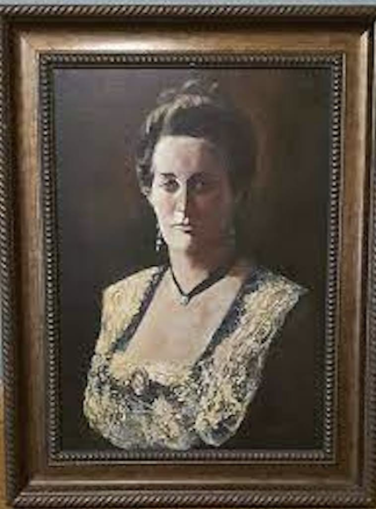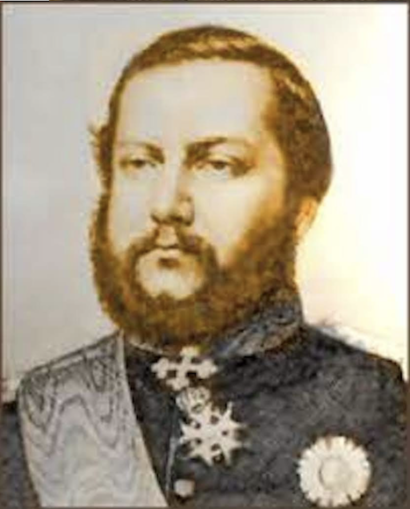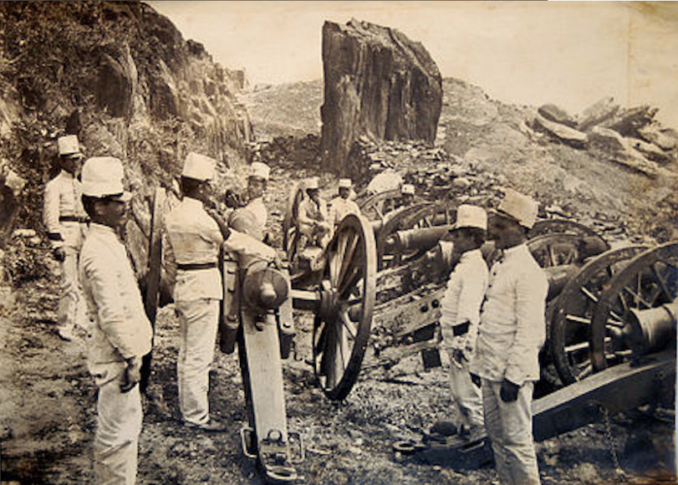More writings by my uncle, John Alldridge. This time he is reporting from South America in 1960 for the Birmingham Evening Mail – Jerry F
Paraguay: The Irish beauty who started a lunatic war
I am sleeping tonight in a palace. A palace with a strange and rather terrible history. And haunted, I feel sure, by the ghost of a lovely woman.
Her name was Eliza Lynch. She was an Irish courtesan whose dark, flamboyant beauty took Paris by storm in the fifties of the last century.

Eliza Lynch,
Pedro C. J. Vera – Licence CC BY-SA 4.0
Among her many lovers was a stout, bearded South American dictator called Francisco Solano Lopez.

Francisco Solano Lopez,
Unknown illustrator, colourised by uploader – Public domain
Blazing with medals, swaggering like a bullfighter, he had come to Europe to the favour of the Great Powers for his tiny, impoverished republic of Paraguay: a country so remote, so little known, that Queen Victoria could not find it on her map.
Instead he met Eliza Lynch. It was one of those fatal fascinations that change the course of history.
For Lopez — half Spanish grandee, half Guarani Indian — had a Napoleon complex. And Eliza saw herself as his Josephine.
She returned with him to Paraguay, to his ramshackle gimcrack capital of Asuncion, and he set her up as his official mistress in this musty old palace which is now the Gran Hotel de Paraguay.
For the next six years she was virtually ruler of Paraguay, this Pompadour from the Dublin slums.
While Lopez made flamboyant proclamations in his sugar-icing palace on the waterfront it was Madame Lynch who took the real decisions up here in her private theatre, where last night I picked my way through a long and rather dreary dinner.
All the time she was feeding her lover’s pathetic delusions of grandeur. Over and over again she insisted that Paraguay must follow its destiny.
He could be Emperor of South America if he wished, and she his Empress. And half a million Paraguayans would follow him to the death.
So in 1865 Lopez embarked on a disastrous war against his three powerful neighbours, Brazil, Argentina, and Uruguay.
I doubt if in all history there has been a more lunatic war than this War of the Triple Alliance. It was as if Switzerland suddenly went mad and declared war on Germany, France, and Italy.
Yet it lasted five years. It was waged with fierce and terrible intensity. The casualties on the Paraguayan side were frightful.
In the final days women and children took up the arms of their dead and fought on.
“We fought desperately,” declared a survivor, “because we loved our land insanely.”
Finally, in a last-ditch defence at Cerra Cora, a few miles north of here, Lopez was killed at the head of his troops, and the war ended. On his body they found a small red leather card case. Inside was a creased and yellowing portrait of Eliza.
They showed it to me yesterday, carefully preserved in a glass case among other rusty dusty bric-a-brac of one of the most disastrous wars in history.
The struggle decimated the nation. Of the half-million who had gone cheerfully into war only 221,000 were left at the end. All but 28,000 of Paraguay’s male population perished.
Ever since, women have done most of the country’s work.
For eight years Paraguay was occupied by the victorious allies. Even after nearly a hundred years the country has never properly recovered from the disaster.
Despite a stupendous, top-heavy-looking hotel block that is being built in the centre of the city, Lopez’s grandiose little capital, which was to have been another Paris, grows steadily more disreputable.
It still has no main sewer. It has only just got its first piped water supply. Its single-decker trams are the oldest I have seen anywhere.
You would think — wouldn’t you? — that after this baleful record the names of Lopez and Lynch would be thankfully forgotten. But not a bit of it. Francisco Solano Lopez is the most venerated of Paraguay’s heroes.
He lies buried in his capital’s Hall of Heroes, a tawdry pocket-sized copy of the Invalides in Paris.
The city’s most imposing avenue is named after him. And his swarthy, bearded face glares up at you, proudly, from every 500-Guaranies note that goes slipping swiftly into the hands of Asuncion’s shopkeepers.
As for Eliza Lynch, she is remembered as a cross between Madame Pompadour and Joan of Arc. She has a memorial in her honour near the cavalry barracks. And there is a move afoot to bring her ashes from Paris and bury them beside her lover in the Hall of Heroes.
Uraguay: Hoy – The word that puts people off their food
Before I arrived in Uruguay my knowledge of Spanish was limited to gracias and buenos dias. Now I can add a fourth word to my fast-growing vocabulary.
The word is hoy. It means today. And no matter where you turn you find it glaring at you in letters two feet high.
To Uruguayans it is the most exciting word in the language. It means that sometime today, in the presence of a senator, two numbers will be drawn out of a drum and some fortunate citizen will be in clover for the rest of his life.
Since this happens three times a week right throughout the year you would think that by now the novelty would have worn off a little.
But to the gambling-mad Uruguayans every hoy could be their lucky day.
They get so worked up about it that on the days of the draw the amount of food consumed throughout Uruguay noticeably decreases. They would rather go hungry than miss their chance of a big win.
Their particular gamble is called Quiniela. You can stake your money on any two-figure number, like your wife’s age or your girlfriend’s vital statistics.
They even have a gambling Saint — San Como — ever since some Italian immigrants from the saint’s hometown won three-quarters of a million pesos (about £30,000) by betting on the date of his birthday.
If you are after bigger stakes there are 16 casinos, all state-owned and going full blast all the year round.
This could give the impression that Uruguayans are a thriftless, workshy lot, living in a sort of glorified Las Vegas.
Nothing could be less true.
Actually the gambling is in a very good cause. The casinos pay for the country’s education and the lotteries for its health.
As a result there is a school every ten miles, the illiteracy rate is the world’s fourth lowest, and Uruguayan teenagers at high-school level can speak English, French and German.
In fact, the average Uruguayan tot is almost frighteningly knowledgeable. A question in a recent general knowledge test for 14-year-olds was “Describe the dress worn by Princess Margaret at her wedding.”
It is this adult approach to life — so different from anything of the kind I have found so far — which has earned Uruguay, the smallest republic in the continent, the sub-title of the South American Denmark.
This was a welfare state long before we got round to thinking about it. They have had a 48-hour working week and a minimum wage-level for over 40 years. There is a free health service and holidays with pay.
And civil servants work only half a day — in the morning in summer and in the afternoon in winter. In return, the state owns practically everything, from public transport and oil refineries to seaside hotels and life insurance.
This iron-clad nationalisation was made possible only because the same political party — the left-wing Coronados (which means Reds, but has nothing to do with Communists) — were in office, without a break, for 93 years.
In 1958 the Opposition party — the Conservative Blancos —growing restive after nearly a century in the wilderness, decided it was time for a change.
For a whole series of changes, in fact.
And the country, heartily sick of 93 years of unbroken Socialist rule, agreed.
Returned to power with an overwhelming majority, the Blancos began a drastic reshuffle. They freed the export-import trade and eliminated artificial, state-fixed rates of exchange.
Imports previously bought with state-subsidised dollars, costing importers as little as 1½ pesos each, now have to be paid for at the free-exchange rate of something like 12 pesos to the dollar.
The plan was fine in theory. Unfortunately the Blancos fell into the same trap as the Coronados. They tried to do too much too quickly. As a result virtually all consumer and industrial goods soared to three and four times the old prices.
Salaries were increased all round to keep workpeople happy. But they range far below the increase in the cost of living.
For instance, a man working in a meat-packing plant now earns 1,000 pesos (about £32) a month. But his wife finds she can buy less than half what she did on 500 pesos two years ago.
So the middle-class businessman of Montevideo, always a hearty eater, now has to pay 4.s. for the steak which two years ago cost him less than a shilling. And as he averages two steaks a day that is quite an item.
Compared to some other countries I’ve visited — Paraguay, for instance — Uruguay is still a paradise.
But the two-and-a-half million people of this pocket-republic were used to the highest standard of living in South America and refuse to settle for less.
Anywhere else on the continent, I suppose, this state of affairs would be an excuse for barricades and fighting in the streets. But the Uruguayans, like the Danes, are peaceful folk.
They have not had a revolution since 1902. Their politics are still a healthy free-for-all, but rarely get beyond a few black eyes.

Fotografía de fuerzas de artillería,
Unknown photographer (CD editado por la Biblioteca Nacional de Uruguay), – Public domain
On my first evening in Montevideo I walked the full length of the magnificent Avenida 18 del Julio, the city’s Oxford Street. At least that was my intention. But halfway up I ran into trouble.
Police on shrieking motorbikes were clearing the street, cavalry horses reared and whinnied.
And the velvety darkness was suddenly full of an acrid smoke that stung my eyes and made them water.
Half-blind with tears I sneaked off down a side street and groped my way back to my hotel.
I discovered afterwards that the textile workers have been on strike for the past three months demanding a 75 per cent wage increase. They had planned a public demonstration which the police had promptly broken up with a few well-aimed tear-gas bombs.
Neither side seems to find anything odd in this; and so far no local newspaper has given it a line. They do these things rather differently in England …
What does rouse the passions of the Uruguayans is football, which — like afternoon tea, a passion for very old motor cars, steak-and-kidney pudding, the railway system, bridge, the long week-end, names like Kelly, MacDonald, and Crocker, polo, and El Omnibus Ingles, which is made in Leyland, Lancashire — they have inherited from the British.
Out of a population of two-and-a-half million there are 2,000 football clubs. The biggest single building in Montevideo is the football stadium, which seats 60,000 and is still not half big enough.
I almost forgot to mention that in happy Uruguay there is no such thing as income tax. Almost the only time on record when all parties voted together was to throw out a bill designed to introduce income tax.
It wasn’t so much that they were against the tax. They knew that in a country where smuggling is almost a national sport they would never be able to collect it …
Reproduced with permission
© 2023 Newspapers.com
Jerry F 2023



